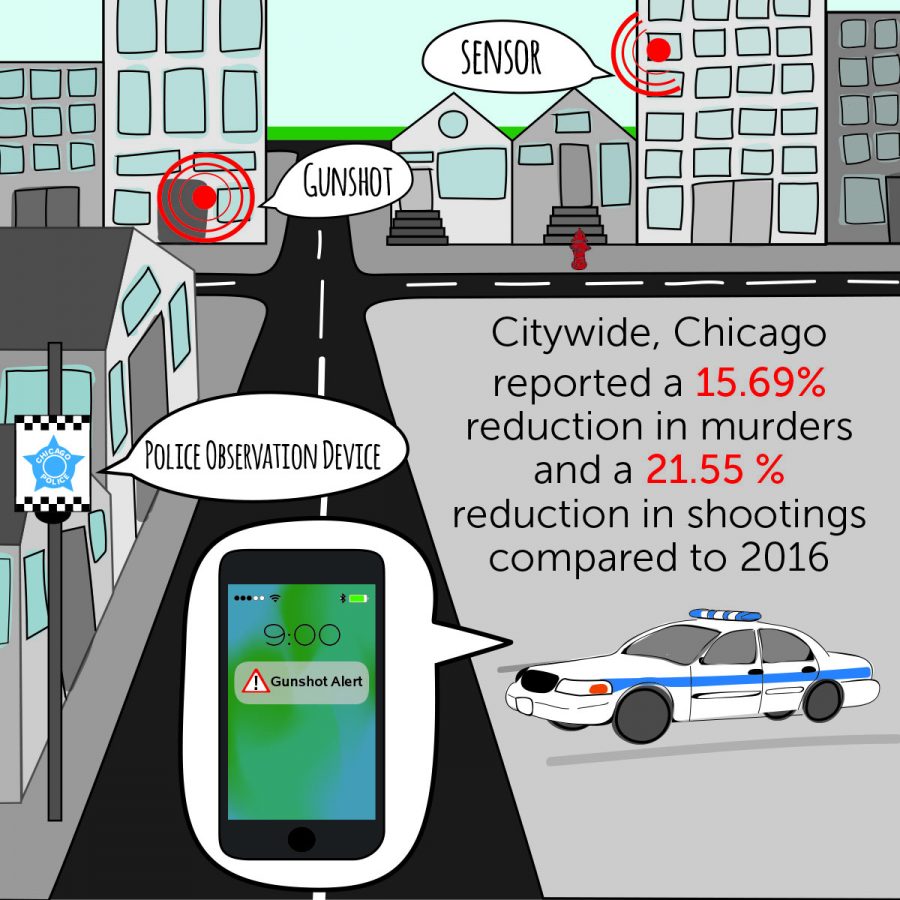CPD attributes gun violence reduction to new tech
CPD attributes gun violence reduction to new tech
January 22, 2018
After a year littered with news headlines about Chicago’s gun violence, the city reported a 21.55 percent reduction in shootings for 2017 compared to 2016.
Mayor Rahm Emanuel and Chicago Police Department Superintendent Eddie Johnson credited the reduction to new policing technologies implemented in 2017. These preventative measures were first used in six CPD districts that have faced challenges with gun violence: 6th (Gresham), 7th (Englewood), 9th (Deering), 10th (Ogden), 11th (Harrison) and 15th (Austin), according to a Jan. 11 city press release.
There were 2,785 shooting incidents in Chicago in 2017, down 765 from last year.
The city announced they will expand the technology in 2018 and have already installed ShotSpotter gunshot detection—a system that uses electronic monitoring to detect gunshots—to cover the 3rd (Grand Crossing) and 4th (South Chicago) police districts on the city’s South Side. They have also increased the number of Police Observation Device crime cameras, according to the city press release.
“ShotSpotter technology allows police agencies to know exactly when, where and how many gunshots were fired in a specific area and [respond] in under one minute,” said Mark Jones, a project director for the National Law Enforcement Partnership to Prevent Gun Violence.
Rather than wait for a 911 call to report a shooting, police receive an alert to their phone, tablet or in-car display terminal that tells with precision where gunfire is occurring, Jones said.
ShotSpotter puts officers at the scene where there is often ballistic evidence linking other crime scenes together, which is where intelligence from the University of Chicago Crime Lab’s Strategic Decision Support Centers comes into play.
At these Strategic Decision Support Centers, CPD treats each police district like a small city, which is working efficiently, Jones said.
“Each [district] has a unique crime problem and [should] not be locked into a one-size-fits-all reduction strategy,” Jones said.
Kim Smith, Research Manager at U of C’s Crime Lab, said the lab is embedding analysts at the support centers to identify crime patterns and trends as they are emerging, as well as evaluating their own methods to see the impact of the centers and how they can improve.
“Based on [the crime lab’s] evaluation in the 7th district, specifically Englewood, we are seeing encouraging results that the SDSC contributed to the reduction in gun violence in that district in 2017,” Smith said.
Jones said while everybody wants to claim credit when there is a gun violence reduction, there is “not a soul in the world who knows exactly why it occurs.”
CPD’s efforts in the last five years have evolved in the right direction though, Jones said, adding that CPD no longer acts as an “occupying force” in neighborhoods where there are high rates of violence. The district is not giving up hope, Jones said.
As a result their efforts have been focused more on outcomes rather than output.
“The combination of using police resources more effectively and data to identify how those resources are used does seem to be contributing to the reduction that we are seeing,” Smith said. “But there is still a lot to be done.”
Colleen Daley, executive director for the Illinois Council Against Handgun Violence, said law enforcement alone cannot solve the gun violence problem and more than just new police technology is needed to reduce it.
“When you’re not funding after school programs, funding resources, mental health, not creating jobs and opportunities, it has a direct impact on communities,” Daley said, referring to the state’s two-year budget impasse. “Nothing stops a bullet like an opportunity. Nothing stops a bullet like a job.”








